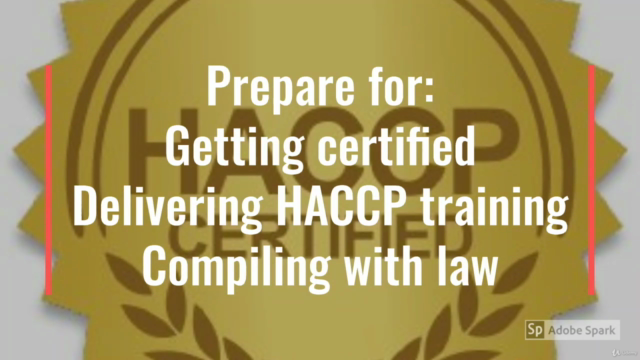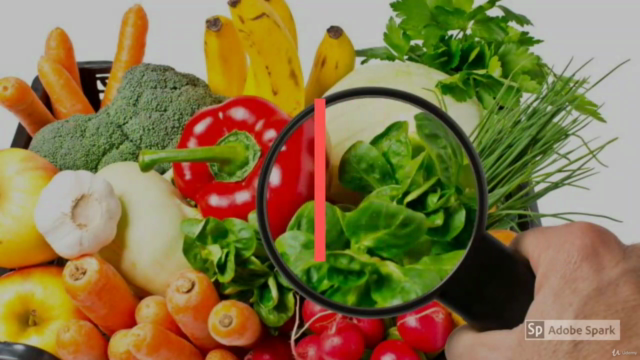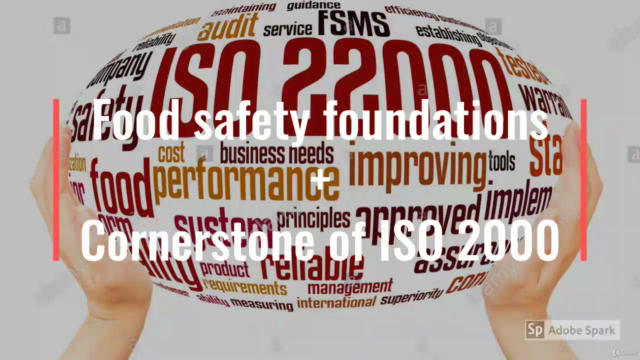HACCP - Hazard Analysis Critical Control Point Certification

Why take this course?
🍽 Master Food Safety with HACCP Certification: A Comprehensive Guide to ISO 22000!
Course Headline: Food Safety Preventive System (HACCP System) for ISO 22000 🚀
Course Description:
Why Choose This Course?
- Comprehensive Curriculum: Learn about the 12 critical tasks/steps to develop a HACCP plan from A to Z.
- Expert Instruction: Benefit from the expertise of Sayed M. Naim Khalid, a seasoned professional in the field of food safety.
- Practical Application: Transition knowledge into action with practical examples and real-world applications.
- ISO 22000 Alignment: Get your HACCP plan aligned with ISO 22000 standards, ensuring global recognition and trust.
Course Outline:
-
Establish a HACCP Team 🤝
- Gather cross-functional expertise to address all aspects of the food safety system.
-
Describe the Product 📋
- Define the food product, including composition and form, to understand its characteristics fully.
-
Identify the Product's Intended Use 🤔
- Clarify the purpose of the product and the conditions under which it will be consumed.
-
Draw Up the Commodity Flow Diagram 🎨
- Map out all stages of production, processing, and distribution to identify potential risks.
-
On-site Confirmation of Flow Diagram 👀
- Validate the flow diagram with actual operations to ensure accuracy and completeness.
-
Identify and Analyse Hazard(s) (Principle 1) 🔍
- Conduct a thorough hazard analysis to pinpoint all real risks associated with your product.
-
Determine the Critical Control Points (CCPs) (Principle 2) 🚦
- Identify key points in the process where control can be applied to prevent a food safety hazard.
-
Establish Critical Limits for Each CCP (Principle 3) 📈
- Set parameters that must be met to ensure the safety of each critical control point.
-
Establish a Monitoring Procedure (Principle 4) 🕒
- Implement consistent monitoring procedures to ensure CCPs remain within set critical limits.
-
Establish Corrective Action (Principle 5) ✍️
- Develop strategies for correcting any deviations from the established critical limits.
-
Verify the HACCP Plan (Principle 6) 🔎
- Check the effectiveness of the HACCP plan through verification procedures.
-
Keep a Record (Principle 7) 📚
- Maintain detailed records to ensure accountability and traceability throughout the process.
Key Topics Covered:
- Food Safety Fundamentals: Understand the importance of food safety and the impact of foodborne illnesses.
- HACCP Principles: Dive deep into the seven principles that underpin effective HACCP systems.
- Risk Assessment: Learn how to identify, evaluate, and control risks associated with food products.
- Documentation and Record Keeping: Master the art of documentation to ensure transparency and compliance.
Who Should Take This Course?
- Food scientists and technologists
- Quality assurance and quality control professionals
- Food business owners and managers
- Food industry personnel responsible for food safety
- Anyone interested in or affected by food safety and HACCP certification
Join us on this journey to safeguard public health and ensure the highest standards of food safety. With the HACCP - Hazard Analysis Critical Control Point Certification, you're not just getting a course; you're investing in a safer future for consumers worldwide! 🌟
Enroll now and take the first step towards becoming a certified HACCP professional! 🎓✨
Course Gallery




Loading charts...
Comidoc Review
Our Verdict
HACCP - Hazard Analysis Critical Control Point Certification course offers a solid foundation in food safety principles required for GFSI certifications. While inconsistent pacing and audio quality issues may cause some inconvenience, expert knowledge, up-to-date content, and clear objectives maintain its overall value to learners seeking HACCP understanding from scratch.
What We Liked
- Comprehensive coverage of HACCP principles, providing a solid foundation for GFSI certifications such as SQF, IFS, BRC, GlobalGAP, Primus, FSSC 22000, and ISO 22000.
- Expert instructor with in-depth knowledge of food safety systems, sharing valuable insights and real-life examples to enhance understanding.
- Well-structured course with clear objectives, progressing from hazard identification to implementing controls, validation, Food Safety Management Plans, and employee training.
- Updated content reflecting the latest regulations and best practices, ensuring students are aligned with current industry standards.
- User-friendly format, making it accessible for beginners learning about HACCP from scratch.
- Availability of subtitles in multiple languages helps cater to a diverse audience.
Potential Drawbacks
- Inconsistent pacing and narration speed can cause difficulty in following the course materials at times, requiring occasional pauses for clarification.
- Some sections may seem overly theoretical or repetitive, potentially causing slight boredom, particularly during parts where tables are read verbatim.
- Limited use of multimedia such as images, videos, or interactive content makes for a less engaging learning experience when compared to more dynamic courses.
- Audio quality issues in some lectures might affect overall user experience, occasionally requiring extra effort from the students to fully comprehend the content.